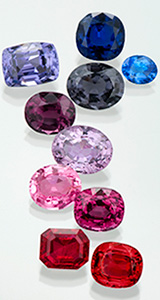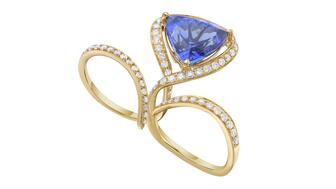Carlos Jose Hernandez and Joshua Zuazo were sentenced to life without the possibility of parole in the 2024 murder of Hussein “Sam” Murray.
Rocks On: Spinel to ‘have its day’
In the November edition of Rocks On, National Jeweler examines the trends in supply, demand and pricing for this increasingly in demand gemstone, which can be red, blue, pink or purple.
New York--Spinel has been, up until the past few years, an underappreciated and undervalued gem with relatively little consumer recognition.

Over the last few years, though, spinel has moved into the spotlight as many of the major brands have begun to work with the gem, attracted by the rich colors of its many varieties.
The various shades of red spinel are so deep, in fact, that for a long time they were mistaken for rubies earning them the name “balas ruby.”
They even were set in crown jewels as rubies. The 170-carat center stone in the British Imperial State Crown is called the “Black Prince’s Ruby” but actually is a blood-red spinel dating back to 14th century Spain. The Crown Jewels also contain another misidentified gemstone--the 350-carat “Timur ruby,” which is actually a red spinel.
It wasn’t until 1783 that mineralogist Jean Baptiste Louis Rome de Lisle identified spinel as a different mineral from rubies.
Today, spinel still costs a fraction of what rubies and sapphires do despite its comparable color and qualities, though that price gap continues to narrow.
A sliding supply
Today, spinel is sourced from Vietnam, Myanmar (Burma), Sri Lanka, and Tajikistan. More recently, new sources were discovered in Tanzania--red spinel was found near Mahenge and the Uluguru Mountains in the late 1980s, as well as near Tunduru after 1994.
These mines near Mahenge had the trade buzzing in the summer of 2007, when spinel crystals as large as 270 carats began surfacing. But even that more recent discovery is starting to run low.
One of the big challenges that faces spinel is the same thing that can be said for many gemstones--demand is continuing to increase while supply is decreasing.
Demand for spinel is far exceeding supply today and the gem is getting harder and harder to come by, especially when it comes to the highest-quality, most-in-demand colors. Larger pieces of rough spinel also are more difficult to find. According to the GIA’s gem encyclopedia, fine quality spinels frequently are cut into less-traditional shapes to preserve their size.
Currently, the most commercially valuable colors of spinel are the rich reds followed by the increasingly rare cobalt blue shades and then the vibrant pinks and oranges. There are also shades of purple, which tend to be less in demand and less expensive.
“I have just returned from Burma today and every red to pink-red spinel with any size is priced to the point that I cannot buy them,” gem dealer Dudley Blauwet told National Jeweler in an email update from his travels. “The supply seemed to be OK, but the economy in Burma is booming with the economic liberalization and local wealthy Burmese, and dealers are competing for the better items.”
Ruben Bindra of B&B Fine Gems said that he is seeing many of the big manufacturers in Europe, companies like Cartier and Bulgari, starting to use pastel-colored spinels in jewelry, especially featuring multiple stones in one piece. This is likely due to the fact that these colors can more easily be purchased in large quantities to allow for designs such as this, he said.
As demand increases and supply decreases prices invariably rise, a trend which seems to be the case for most gems in the market these days, Bindra noted.
“Over the last five years, almost every gem we deal in has increased in price,” he said. “Anything of value--everything has gone up in price tremendously.”
He adds that though spinel still seems to be the undervalued stone of the gem world, he has seen demand for it increase greatly over the past four to five years. “This could be because it’s what was available, or because it’s also a hard stone (an 8 on the Mohs scale) so jewelers like to work with it. Or it could be because it’s easier to work with since it comes in so many colors.”
Regev reiterated this statement, stating that he likes the fact that spinel has the “in-between” shades that really help Carelle's designs come to life.
He also noted that, “Durability is a big thing. Whenever we set an emerald or certain semi-precious stones, I worry a lot about the stone breaking. With spinel I don’t need to worry as much and, once the piece is ready, the stone has an almost unsurpassed brilliance.”
All black everything
Just as the stone’s red and blue shades have benefited from their resemblance to sapphires and rubies, so too has spinel’s cheaper variety--the black spinel--gained from its resemblance to dark diamonds.
As the popularity of black diamonds has skyrocketed even over just the past year, brands have begun turning to black spinel to create the same look at a lower price point.
The stone also can serve as a replacement for black onyx, especially because it is a much harder stone and offers a great brilliance and luster, Regev noted. Also, black spinel normally isn’t treated whereas black onyx usually has been dyed.
“Black spinel is doing great, and I do not think the consumers are having an issue purchasing pieces that incorporate black spinel,” Regev said, “but I also believe that that has to do with the different price point that one can reach using black spinel.”
But perhaps spinel’s biggest challenge, and also possibly its biggest upside, is that it still has a ways to go when it comes to recognition, in any shade.
“I think that a lot of people still aren’t aware of what spinel is,” said gem dealer Evan Caplan. “And when consumers hear the word, they think that it might be synthetic because they don’t know enough about it.”
As the big brands begin to use the gemstone and more designers incorporate the various shades of spinel into their pieces, it’s only a matter of time before spinel will get the consumer appreciation many think it deserves, Bindra said.
“The initial challenge for spinel was the name recognition, which I think has mostly been crossed. It will soon trickle down to the consumer level now that designers and manufacturers are using it,” Bindra said. “(Spinel) is an underrated stone and it is an undervalued stone, but it’s going to have its day.”
The Latest

Yood will serve alongside Eduard Stefanescu, the sustainability manager for C.Hafner, a precious metals refiner in Germany.

The New Orleans jeweler is also hosting pop-up jewelry boutiques in New York City and Dallas.

How Jewelers of America’s 20 Under 40 are leading to ensure a brighter future for the jewelry industry.

Set in a Tiffany & Co. necklace, it sold for $4.2 million, the highest price and price per carat paid for a Paraíba tourmaline at auction.


The jeweler’s “Deep Freeze” display showcases its iconic jewelry designs frozen in a vintage icebox.

Take luxury gifting to new heights this holiday season with the jeweler’s showstopping 12-carat sphene ring.

Roseco’s 704-page catalog showcases new lab-grown diamonds, findings, tools & more—available in print or interactive digital editions.

This year's theme is “Unveiling the Depths of the Ocean.”

In its annual report, Pinterest noted an increase in searches for brooches, heirloom jewelry, and ‘80s luxury.

Starting Jan. 1, customers can request the service for opal, peridot, and demantoid garnet.

The 111-year-old retailer celebrated the opening of its new location in Salem, New Hampshire, which is its third store in the state.

The new catalog features its most popular chains as well as new styles.

The filmmaker’s personal F.P. Journe “FFC” prototype was the star of Phillips’ recent record-setting watch auction in New York.

The new location in the Design District pays homage to Miami’s Art Deco heritage and its connection to the ocean.

Inflations, tariffs, and politics—including the government shutdown—were among consumers’ top concerns last month.

“Longtime favorite” presenters, as well as first-time speakers, will lead talks and workshops at the annual event in Tucson next year.

Silas Smith of Meridian Metalworks won the challenge with his pendant that blends Australian and American landscapes.

The sale of the 31.68-carat, sunset-hued stone was part of Sotheby’s first series of events and auctions in Abu Dhabi.

Most customers who walk into your store this month have made up their minds. Your job is to validate their choice, Emmanuel Raheb writes.

The collection features characters and motifs from Ukrainian folklore, including an enchanted mirror and a magic egg.

MatrixGold 3.11, the newest version of the jewelry design program, offers more flexibility, precision, and creative control.

The pavilion will be part of the 2026 JA New York Spring show, scheduled for March 15 to 17.

Kadet, a 1994 National Jeweler Retailer Hall of Fame inductee, helped grow the family-owned retailer in the Chicago area and beyond.

Billed as the world’s smallest wearable, Lumia Health’s new smart earrings have a health tracker subtly embedded in the back.

Don’t let those with December birthdays feel blue. Help them celebrate their month with blue zircon, turquoise, and tanzanite.

The new pink sapphire version of the piece dances with its wearer in the brand’s “Icons After Dark” holiday campaign.

























